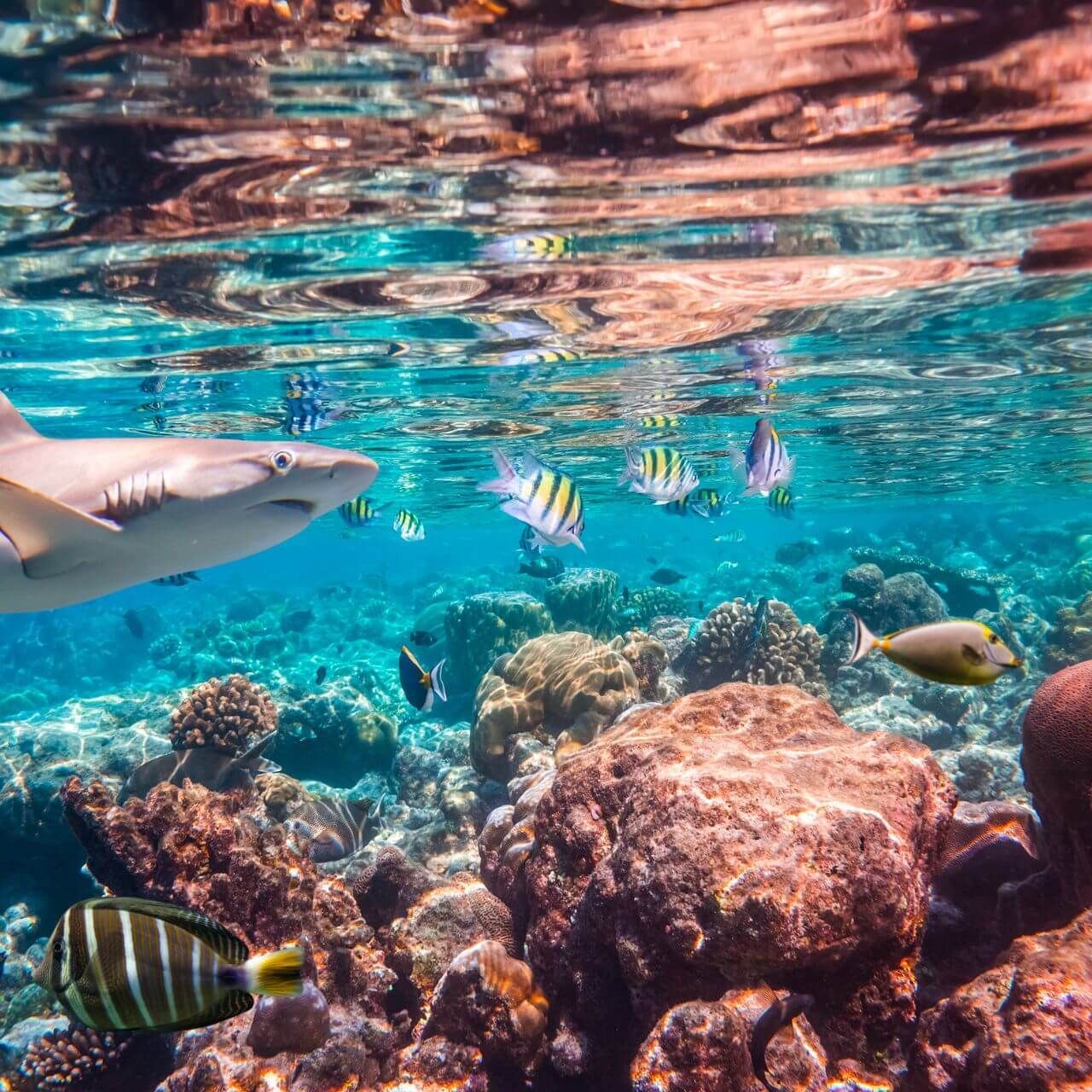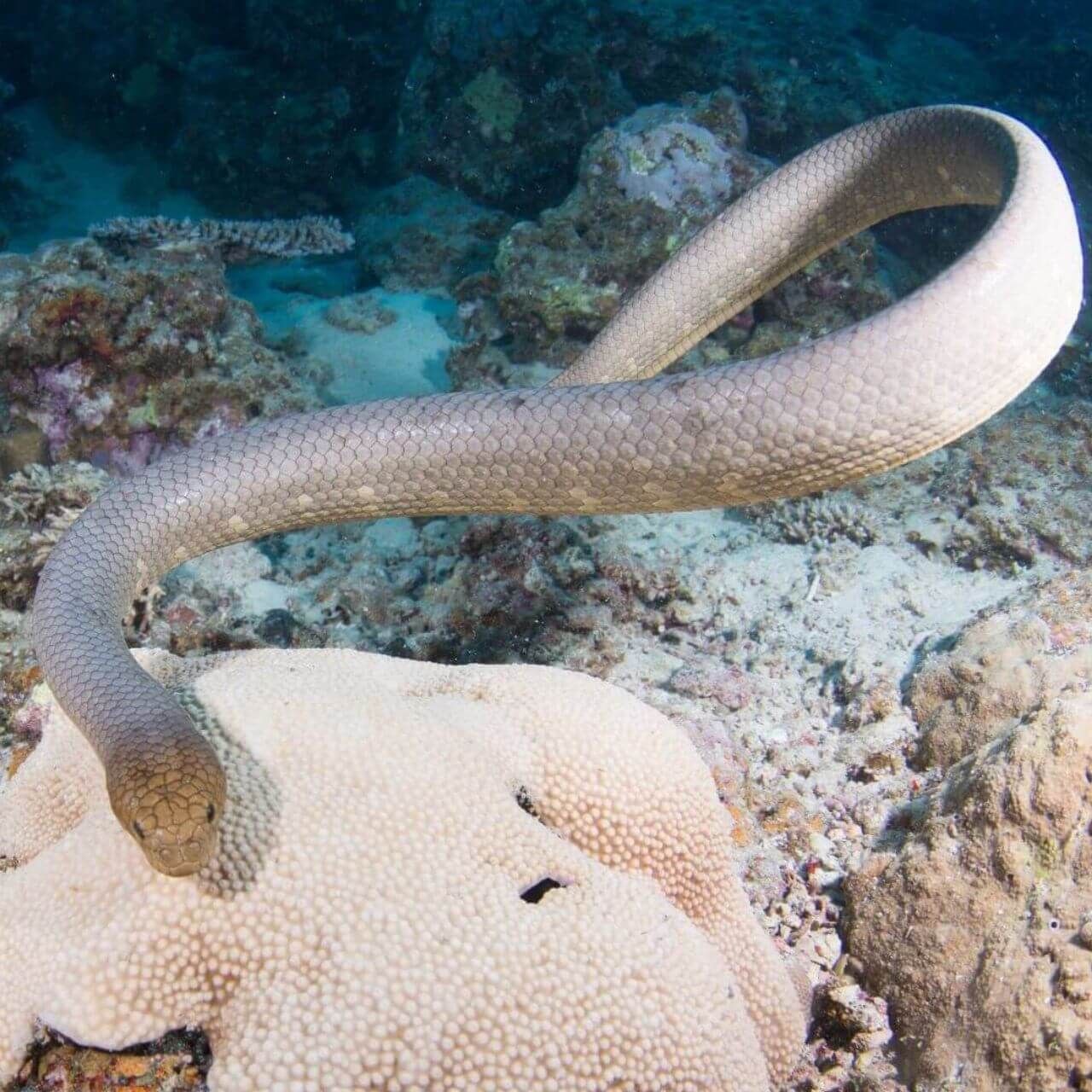Sea Snakes

Let's Learn About Sea Snakes
Word of the Week
Dry Bite
When a venomous snake bites but does not inject any venom, it is called a dry bite. Scientists are still researching how and why venomous snakes deliver dry bites.
Scientists hypothesize that dry bites can happen as a result of a physical issue with the snake or a deliberate way to conserve their venom supply.
Fast Facts

Where do sea snakes live?
Sea snakes are found in the warm, coastal waters of the Indo-Pacific.
Sea snakes are sometimes called coral reef snakes because they are frequently found in tropical reef ecosystems. They can also be found in mangrove forests, along rocky ocean floors, and one species even inhabits the open ocean.
What do sea snakes eat?
Sea snakes are carnivores.
Like other snakes in the elapid family, sea snakes use their strong venom to catch prey. Most sea snakes feed on fish, though some species specialize in eating eels and fish eggs. Their long, narrow body allows them to hunt deep inside of coral reefs.


What traits do sea snakes share?
Sea snakes are divided into two groups: true sea snakes and sea kraits. Though they have several differences, they do have quite a bit in common.
- Sea snakes are air-breathing reptiles.
- Sea snakes are cold-blooded (ectothermic).
- Sea snakes move using a flat, paddle-like tail.
- Sea snakes smell with their tongues (just like snakes on land!).
- Sea snakes are carnivores.
How many sea snakes are there?
There are 69 species of sea snakes.
Sea snake species vary in conservation status. Most species are not at risk of extinction, with 2 species are listed by the IUCN as critically endangered.

Species Spotlight
Banded Sea Krait
Laticauda colubrina
All sea snakes are native to the Indo-Pacific (where the Indian and Pacific Oceans meet), but the banded sea krait can only be found off the coast of southern Asia into the tropical islands of the western Pacific. Banded sea kraits, which are also known asXXXXXX yellow-lipped sea kraits, inhabit They measure about x ft long, making them relatively small for a sea snake. They share many traits with other sea snakes, such as their aquatic lifestyle, tropical habitat, paddle-like tail, and carnivorous diet. Banded sea kraits seem to have a favorite food--eels! Like all sea kraits, they have some key differences from a true sea snake. Sea kraits are capable of moving on land, while true sea snakes are not. Sea kraits also lay eggs (oviporous) while true sea snakes have live offspring (ovoviviporous). When it's time to lay her eggs, a female banded sea krait will travel onto the beach and lay her eggs in a hold in the sand. True sea snakes have their live offspring in the ocean; they're able to hide and defend themselves as soon as their born. To help move on land, sea kraits also have wide belly scales, while true sea snakes do not!
BRAIN BLAST
Sea snakes are unusual for many reasons, including that they are reptiles that live in the ocean! Do any other reptiles live in the ocean? If so, what are they?
Conservation Corner
Coral Bleaching
While most sea snake species are not threated with extinction, the coral reef habitats they call home are certainly facing threats. Corals only thrive under perfect conditions--the right water temperature, the proper amount of sunlight, and just enough oxygen and carbon in the water. Unfortunately, the conditions where corals live are changing. Water temperature is warming and there is too much carbon; this causes corals to die off. When corals die, they lose their color, so we call this process coral bleaching.
Coral bleaching is a big problem for sea snakes and every other organism that calls coral reefs their home. Reefs support plants and animals of every size by providing food and shelter. Small fish feed on algae growing on the living reef before they become food for bigger fish and other predators, like sea snakes! As the small fish disappear from a bleaching reef, their predators will disappear soon after. To protect coral reefs, sea snakes, and thousands of other species, we can reduce our energy use or use renewable energy. We can also write to our local governments to encourage them to make renewable energy more available!
True Sea Snakes Vs. Sea Kraits
Determine which traits belong to true sea snakes, sea kraits, or all sea snakes!
Sea Snake Challenge
Learn More!
*Warning: Eagle hunting, catching, & eating sea snake*
Glossary
Adaptation
The process by which a species becomes more fit for its environment over the course of several generations. It is a result of natural selection.
Aquatic
Living in water.
Camouflage
The ability for an organism to blend into their surroundings usually to hide from prey or predators.
Carnivore
An animal that eats other animals.
Ectotherm
An animal that relies on the outside temperature to regulate their body temperature (reptiles and amphibians). Also known as cold-blooded.
Endotherm
An animal that regulates their body temperature internally (mammals and birds). Also known as warm-blooded.
Gills
The respiratory organ that allows fish, amphibians in their larval phase, and crustaceans to absorb oxygen molecules from water.
Predator
An animal that hunts other animals for food.
Prey
An animal that is hunted and eaten by another animal.
Reptile
A group of ectothermic (cold-blooded) vertebrates that are covered in scales and generally lay eggs.
Species
A closely related group of animals with similar characteristics that are capable of reproducing (example: tigers).
Vertebrate
An animal that has a backbone.
Sign Up for our Newsletter
Stay up to date with new adventures, live classes, deals, and more!

Helpful Resources
*Please note we do not offer refunds for EdZOOcating Adventures memberships. We recommend you explore the 3-day free trial prior to subscribing!*



